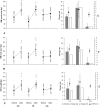The effect of resistance training set configuration on strength and muscular performance adaptations in male powerlifters
- PMID: 33846516
- PMCID: PMC8041766
- DOI: 10.1038/s41598-021-87372-y
The effect of resistance training set configuration on strength and muscular performance adaptations in male powerlifters
Abstract
The purpose of this study was to determine the effects of different set configurations on strength and muscular performance adaptations after an 8-week resistance training program. Twenty-four male powerlifters participated in this study and were randomly assigned to one of two resistance training groups: (1) cluster sets (CS: n = 8), (2), traditional sets (TS: n = 8), and a control group (CG: n = 8). All powerlifters were evaluated for thigh and arm circumference, upper and lower body impulsive activities, and 1 repetition maximum (1RM) in the back squat, bench press, and deadlift prior to and after the 8-week training intervention. After training, both the CS and TS groups increased arm and thigh circumferences and decreased body fat. The CS group resulted in greater increases in upper and lower body impulsive activities than the TS group, respectively. In addition, the CS and TS groups indicated similar changes in 1RM bench press, back squat, and deadlift following the 8 weeks training intervention. These results suggest that cluster sets induce adaptive changes that favor impulsive activities in powerlifters.
Conflict of interest statement
The authors declare no competing interests.
Figures



Similar articles
-
Similar adaptive responses in the upper body physical performance of table tennis players following the traditional and cluster set resistance and plyometric training.Sci Rep. 2024 Nov 14;14(1):28001. doi: 10.1038/s41598-024-78795-4. Sci Rep. 2024. PMID: 39543223 Free PMC article.
-
Modified Daily Undulating Periodization Model Produces Greater Performance Than a Traditional Configuration in Powerlifters.J Strength Cond Res. 2016 Mar;30(3):784-91. doi: 10.1519/JSC.0000000000001165. J Strength Cond Res. 2016. PMID: 26332783
-
The effect of resistance training set configuration on strength, power, and hormonal adaptation in female volleyball players.Appl Physiol Nutr Metab. 2018 Feb;43(2):154-164. doi: 10.1139/apnm-2017-0327. Epub 2017 Oct 10. Appl Physiol Nutr Metab. 2018. PMID: 29017017 Clinical Trial.
-
Effects of Augmented Eccentric Load Bench Press Training on One Repetition Maximum Performance and Electromyographic Activity in Trained Powerlifters.J Strength Cond Res. 2021 Jun 1;35(6):1512-1519. doi: 10.1519/JSC.0000000000004030. J Strength Cond Res. 2021. PMID: 34027918
-
Effects of different resistance training volumes on strength and power in team sport athletes.J Strength Cond Res. 2013 Jul;27(7):1832-40. doi: 10.1519/JSC.0b013e3182736d10. J Strength Cond Res. 2013. PMID: 23044934 Review.
Cited by
-
Similar adaptive responses in the upper body physical performance of table tennis players following the traditional and cluster set resistance and plyometric training.Sci Rep. 2024 Nov 14;14(1):28001. doi: 10.1038/s41598-024-78795-4. Sci Rep. 2024. PMID: 39543223 Free PMC article.
-
Effects of Cluster vs. Traditional Sets Complex Training on Physical Performance Adaptations of Trained Male Volleyball Players.J Sports Sci Med. 2024 Dec 1;23(4):822-833. doi: 10.52082/jssm.2024.822. eCollection 2024 Dec. J Sports Sci Med. 2024. PMID: 39649557 Free PMC article. Clinical Trial.
-
Effect of Tibialis Anterior Neuromuscular Electrical Stimulation-Induced Eccentric Contraction Training on Single-Leg Standing: A Pilot Study.Sensors (Basel). 2025 Apr 13;25(8):2455. doi: 10.3390/s25082455. Sensors (Basel). 2025. PMID: 40285145 Free PMC article.
-
Creatine Enhances the Effects of Cluster-Set Resistance Training on Lower-Limb Body Composition and Strength in Resistance-Trained Men: A Pilot Study.Nutrients. 2021 Jul 4;13(7):2303. doi: 10.3390/nu13072303. Nutrients. 2021. PMID: 34371813 Free PMC article. Clinical Trial.
References
-
- Fleck SJ, Kraemer WJ. Designing Resistance Training Programs. 3. Human Kinetics; 2004.
Publication types
MeSH terms
LinkOut - more resources
Full Text Sources
Other Literature Sources

